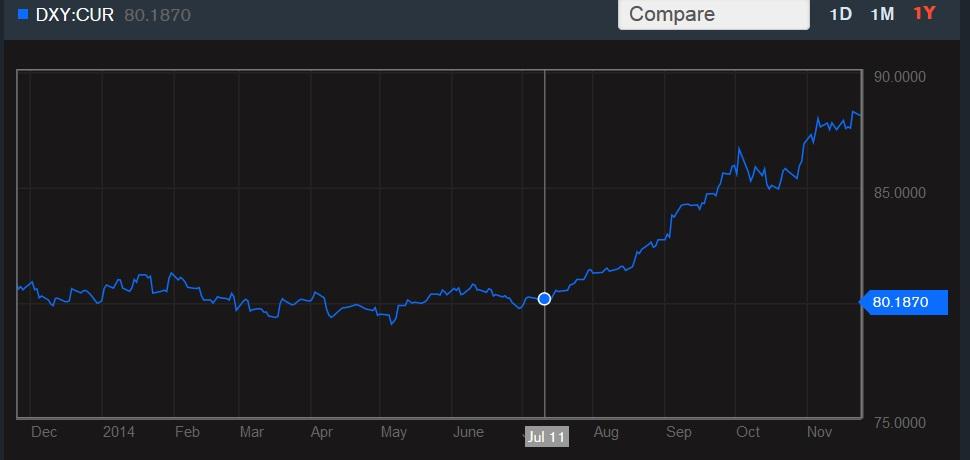Outlook:
The Market News fixed income analyst wrote yesterday “Both the Treasury and the agency mortgage-backed securities markets remained well bid on Monday as it is just too hard to fight the fact that Europe, Japan and China are still in aggressive easing mode. Given these circumstances, American bond traders and investors cannot rule out the thought that the Federal Reserve may not be able to tighten as early as many had hoped for. And the tightening may be far more limited as well.”
See the downward-sloping trendline of the 10-year note yield in the Chart Package. This is not the trend-line of a currency rally. The dollar is indeed higher across the board from six months or a year ago. The DXY chart on the enxt page is from Bloomberg. The dollar index started rallying in July, and the CFTC Commitments of Traders report shows a net long dollar position against all the majors. But if a rally lacks support from rising yields, is it a legless rally? This is the big worry. Many analysts say we have competitive devaluation (currency war) from Europe, Japan and now probably China, and that is the im-petus for the dollar. But a rally is always best-served by outright buying on virtue than buying by default because you are selling something else.
John Plender in the FT writes that “… US interest rates are supportive of a strong dollar. The 10-year US Treasury bond yields more today than the equivalent IOUs of Italy and Spain, which some might find faintly surreal given the much greater questions about debt sustainability in these European coun-tries. And 10-year Treasuries yield three times as much as equivalent German Bunds.”
In other words, the ascendant dollar is not to be questioned. We don’t buy it. Yield advantage is not the only factor. You need rising yield in the target currency, too. The proof is in the pudding—the euro has failed (so far) to dip to a level commensurate with falling European yields. By now, with only 5 weeks to go to year-end, we had thought we’d have the euro at 1.2000 or so. So did a majority of fore-casters. And yet we keep flirting with 1.2500 and a potential target around 1.2600, the high only last Friday. The euro could easily test that last high, if only to inspire another round of sell-at-the-high.
Some analysts try to make hay out of discord at the BoJ—only 5 of 9 members voted for the Oct increase in QE—and at the ECB. Yesterday the BBK chief Weidmann said the ECB would have a very hard time getting sovereign QE approved—but these are all things that don’t pass the “So-What?” test. What matters is not the arguments behind closed doors that we get second-hand, but what actions are taken. And no one doubts that the ECB will start QE of some description, whether it’s at next week’s policy meeting or later, in January.
If everyone expects it, it should be getting built in to the euro. And if it were built-in, the euro would be headed for 1.2000, not making a new high overnight at 1.2440. If this is just positioning and game-playing by the big boys, it’s getting annoying. It’s also very dangerous for the small trader, who should be closing out positions until next week.
Note to Readers: Next Thursday (Nov 27) is Thanksgiving in the US, a national holiday (that pur-ports to celebrate the Indians helping out the Pilgrims with food and look how we are repaying them, a disgrace on a par with slavery). We will not publish any reports on Thursday and only the traders’ re-ports on Friday.
This morning FX briefing is an information service, not a trading system. All trade recommendations are included in the afternoon report.
Recommended Content
Editors’ Picks
AUD/USD hovers around 0.6500 amid light trading, ahead of US GDP

AUD/USD is trading close to 0.6500 in Asian trading on Thursday, lacking a clear directional impetus amid an Anzac Day holiday in Australia. Meanwhile, traders stay cautious due ti risk-aversion and ahead of the key US Q1 GDP release.
USD/JPY finds its highest bids since 1990, near 155.50

USD/JPY keeps breaking into its highest chart territory since June of 1990 early Thursday, testing 155.50 for the first time in 34 years as the Japanese Yen remains vulnerable, despite looming Japanese intervention risks. Focus shifts to Thursday's US GDP report and the BoJ decision on Friday.
Gold price treads water near $2,320, awaits US GDP data

Gold price recovers losses but keeps its range near $2,320 early Thursday. Renewed weakness in the US Dollar and the US Treasury yields allow Gold buyers to breathe a sigh of relief. Gold price stays vulnerable amid Middle East de-escalation, awaiting US Q1 GDP data.
Injective price weakness persists despite over 5.9 million INJ tokens burned

Injective price is trading with a bearish bias, stuck in the lower section of the market range. The bearish outlook abounds despite the network's deflationary efforts to pump the price. Coupled with broader market gloom, INJ token’s doomed days may not be over yet.
Meta Platforms Earnings: META sinks 10% on lower Q2 revenue guidance Premium

This must be "opposites" week. While Doppelganger Tesla rode horrible misses on Tuesday to a double-digit rally, Meta Platforms produced impressive beats above Wall Street consensus after the close on Wednesday, only to watch the share price collapse by nearly 10%.
